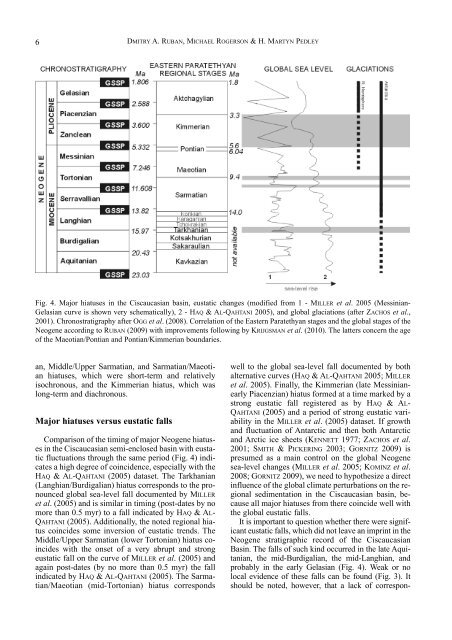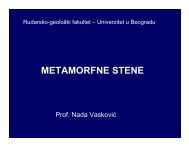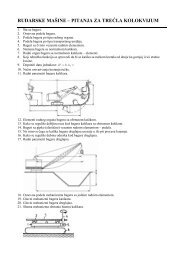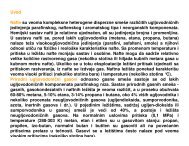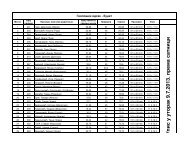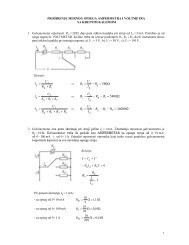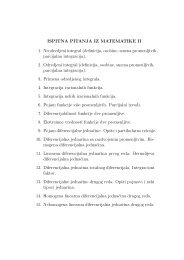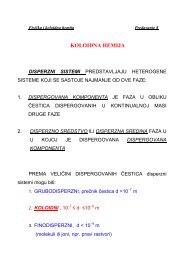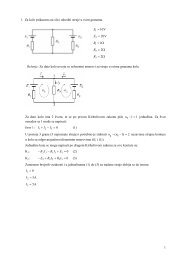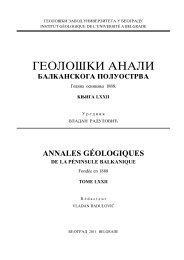KÑига LXXI - Univerzitet u Beogradu
KÑига LXXI - Univerzitet u Beogradu
KÑига LXXI - Univerzitet u Beogradu
You also want an ePaper? Increase the reach of your titles
YUMPU automatically turns print PDFs into web optimized ePapers that Google loves.
6<br />
DMITRY A. RUBAN, MICHAEL ROGERSON & H. MARTYN PEDLEY<br />
Fig. 4. Major hiatuses in the Ciscaucasian basin, eustatic changes (modified from 1 - MILLER et al. 2005 (Messinian-<br />
Gelasian curve is shown very schematically), 2 - HAQ & AL-QAHTANI 2005), and global glaciations (after ZACHOS et al.,<br />
2001). Chronostratigraphy after OGG et al. (2008). Correlation of the Eastern Paratethyan stages and the global stages of the<br />
Neogene according to RUBAN (2009) with improvements following by KRIJGSMAN et al. (2010). The latters concern the age<br />
of the Maeotian/Pontian and Pontian/Kimmerian boundaries.<br />
an, Middle/Upper Sarmatian, and Sarmatian/Maeotian<br />
hiatuses, which were short-term and relatively<br />
isochronous, and the Kimmerian hiatus, which was<br />
long-term and diachronous.<br />
Major hiatuses versus eustatic falls<br />
Comparison of the timing of major Neogene hiatuses<br />
in the Ciscaucasian semi-enclosed basin with eustatic<br />
fluctuations through the same period (Fig. 4) indicates<br />
a high degree of coincidence, especially with the<br />
HAQ & AL-QAHTANI (2005) dataset. The Tarkhanian<br />
(Langhian/Burdigalian) hiatus corresponds to the pronounced<br />
global sea-level fall documented by MILLER<br />
et al. (2005) and is similar in timing (post-dates by no<br />
more than 0.5 myr) to a fall indicated by HAQ & AL-<br />
QAHTANI (2005). Additionally, the noted regional hiatus<br />
coincides some inversion of eustatic trends. The<br />
Middle/Upper Sarmatian (lower Tortonian) hiatus coincides<br />
with the onset of a very abrupt and strong<br />
eustatic fall on the curve of MILLER et al. (2005) and<br />
again post-dates (by no more than 0.5 myr) the fall<br />
indicated by HAQ & AL-QAHTANI (2005). The Sarmatian/Maeotian<br />
(mid-Tortonian) hiatus corresponds<br />
well to the global sea-level fall documented by both<br />
alternative curves (HAQ & AL-QAHTANI 2005; MILLER<br />
et al. 2005). Finally, the Kimmerian (late Messinianearly<br />
Piacenzian) hiatus formed at a time marked by a<br />
strong eustatic fall registered as by HAQ & AL-<br />
QAHTANI (2005) and a period of strong eustatic variability<br />
in the MILLER et al. (2005) dataset. If growth<br />
and fluctuation of Antarctic and then both Antarctic<br />
and Arctic ice sheets (KENNETT 1977; ZACHOS et al.<br />
2001; SMITH & PICKERING 2003; GORNITZ 2009) is<br />
presumed as a main control on the global Neogene<br />
sea-level changes (MILLER et al. 2005; KOMINZ et al.<br />
2008; GORNITZ 2009), we need to hypothesize a direct<br />
influence of the global climate perturbations on the regional<br />
sedimentation in the Ciscaucasian basin, because<br />
all major hiatuses from there coincide well with<br />
the global eustatic falls.<br />
It is important to question whether there were significant<br />
eustatic falls, which did not leave an imprint in the<br />
Neogene stratigraphic record of the Ciscaucasian<br />
Basin. The falls of such kind occurred in the late Aquitanian,<br />
the mid-Burdigalian, the mid-Langhian, and<br />
probably in the early Gelasian (Fig. 4). Weak or no<br />
local evidence of these falls can be found (Fig. 3). It<br />
should be noted, however, that a lack of correspon-


